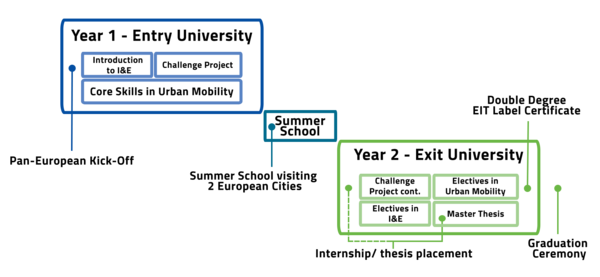Students need to pass at least 120 ECTS during the two-year study. Apart from skills in Urban Mobility, the program focusses on Innovation and Entrepreneurship (I&E) skills as well. In addition to the courses you take, you need to spend at least four weeks of internship with an organization outside of the university. This ensures you are introduced to the day-to-day challenges that arise in urban mobility-related work.
Schematically, the curriculum structure looks as follows:

More information regarding the curriculum at each university, including the list of courses, can be found below.
Track and premaster information
Track info: The ABP Master track Sustainable Urban Mobility Transitions (SUMT) is part of the EIT Urban Mobility Master School. Since the program is hosted by two universities, it is important to check the curriculum of each partner university before deciding on your entry and exit university.
Premaster info: No premaster is available for this track. TU/e-Bachelor Students with an interest in the field of Sustainable Urban Mobility Transitions are recommended to follow packages such as Smart Mobility Design, Urban Systems and Real Estate 2.
Your graduation project
You will compile your master thesis by securing an appropriate placement at an urban mobility-related organization for a minimum period of eight weeks. The thesis accounts for 30 ECTS.
Your thesis topic should enable you to demonstrate the full range of the key competencies you have gained. This is expressed in several objectives:
- You will demonstrate your scientific competencies by carrying out the thesis work with appropriate scientific rigor.
- You will also demonstrate your ability to translate the innovations that result from scientific work into solutions that can be feasibly implemented.
- Finally, you will make a contribution that has real value to an organization in the urban mobility sector.
Your thesis will be evaluated by members of your evaluation committee. This consists of one member from your entry university, at least one member from your exit university and a representative of the company where you are placed for part of your graduation project period. The main assessment criteria concern the quality of your research or design, your own working and learning process, and your written and oral communication skills.